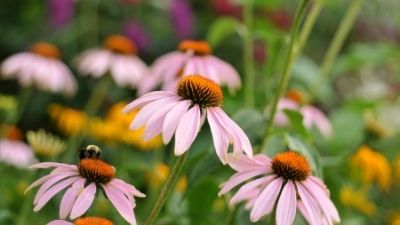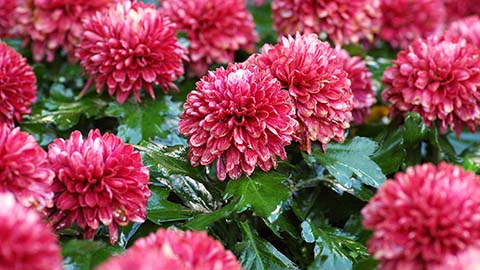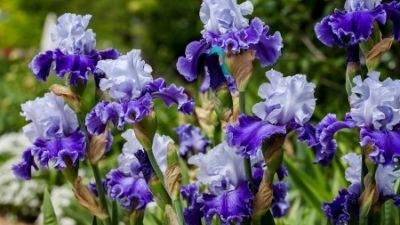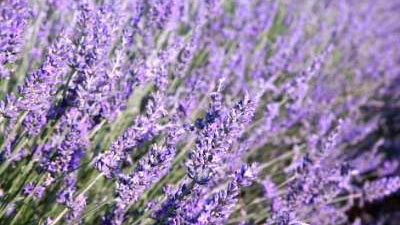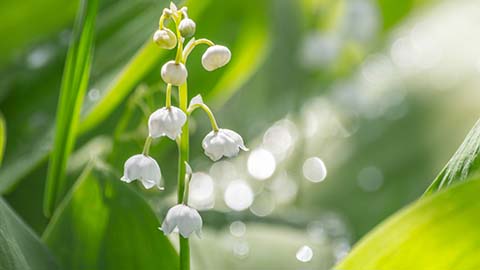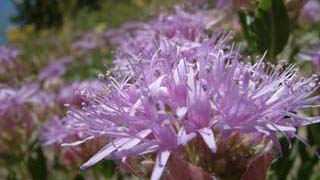Putting the Yard and Garden to Bed
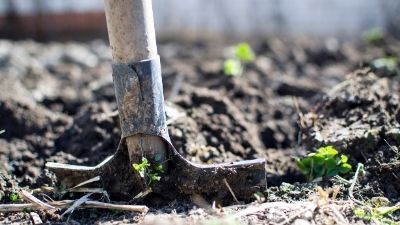
By the time frost covers the lawn at the end of the season, many gardeners, like their plants, are spent. It is all too easy for gardeners to go dormant like their plants. By accomplishing a few simple chores before the snow flies, gardeners can ensure an easier start to the next spring season. Here are some suggestions for getting the yard and garden ready for winter.
Clean Up the Garden
Remove all vines, stems, leaves and other litter from the vegetable garden once the final harvest has happened. Add the refuse to the compost pile or take it to the local landfill or green waste facility. This will reduce hiding places for insect pests, such as squash bugs, and may keep diseases, such as powdery mildew, from building up.
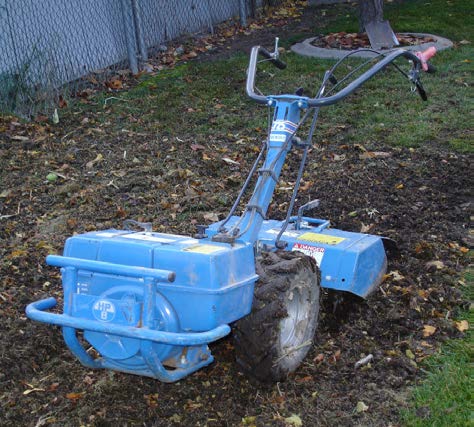
JayDee Gunnell).
Tilling or cultivating garden soil in the fall is better than waiting until spring. Wanting to get a jumpstart on the season, anxious gardeners often do so in early in the spring, when soil is still too wet. This can create compaction issues, especially in heavy, clay soils. Tilling when the soil is too wet can also damage soil structure and create hard clods that are difficult to deal with later. Tilling during the fall months is a great time to incorporate composted organic matter into the soil. Tilling in the fall also exposes and kills many overwintering grasshopper egg masses, helping to reduce next year’s population.
Cut Back and Divide Crowded Perennials
Wait for foliage to die on perennials before cutting them to the ground. This allows for the most energy to be stored in the roots for next year’s growth. If older perennials become crowded or start to die out in the middle, divide them by cutting the clump in half or thirds with a spade or garden fork. As a rule, perennials that bloom in the spring should be divided in the fall. Perennials that bloom in the fall should be divided in the spring. In the fall, divide and plant 3 to 4 weeks before the ground freezes.
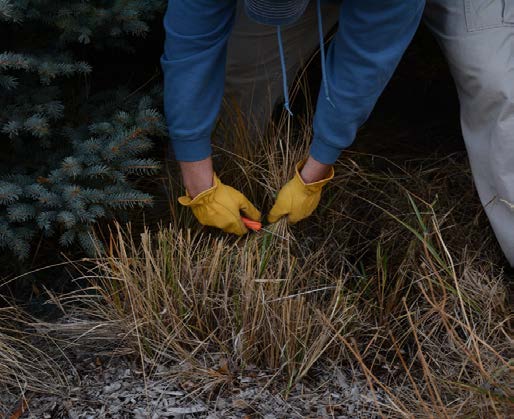
JayDee Gunnell)
This gives the new divisions time to settle into their new homes
Some perennials are not adapted to Utah’s cold winters. We refer to them as tender. These include tuberous begonia, dahlia, gladiola, and canna lily. If properly stored, they can be saved and replanted the following year. Allow the leaves to die down, and cut them off 1 to 3 inches above ground. Carefully dig the crown and roots and allow them to cure (dry) in a warm area, such as a garage, for 1 to 2 weeks.
After curing, the tender perennials should be stored in a cool, dry area at 45 to 50 degrees. Old nursery buckets or garbage bins make great storage containers. Layer the cured plants in vermiculite, sand, sawdust, potting soil or peat moss to for allow air circulation and prevent rot. Check the bins each month, removing any soft or rotting plants. Dahlias and tuberous begonias may shrivel if they are stored too dry or with low humidity. If this occurs, place an open cup of water in with the stored root structures. As the water evaporates, it will help increase the humidity.
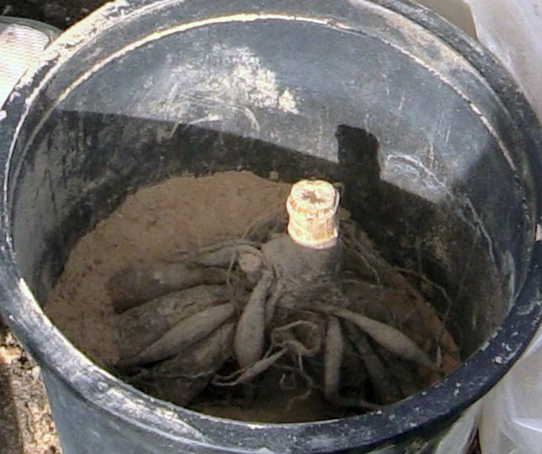
Add Compost
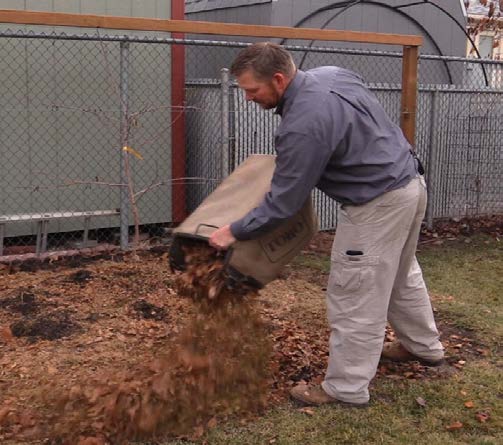
(Image: JayDee Gunnell)
Compost (or organic matter) is potentially anything that was once living tissue. It is the best thing you can add to your garden soil. It improves water holding capacity, drainage, and tilth (structure) of the soil (Heaton 2010). Compost also acts as longterm storage for nutrients. Every season, add 2 to 3 inches of well composted organic matter for every 6 inches of tilling depth to improve the soil.
The best plant-derived compost is free from your own yard and includes things such as leaves and grass clippings. When adding organic matter to a soil, keep in mind that using dried (brown) materials, such as sawdust, leaves or corn stalks, additional nitrogen fertilizers should be added to help soil microbes break it down (Farrell-Poe, 2011). Chopping leaves with a lawnmower or yard vacuum will also help speed up the composting process. Generally, for every inch of brown material in a 100 ft2 area (10 ft. x 10 ft.), add ¼ pound of actual nitrogen – or about 1 pound of ammonium sulfate (21-0-0) fertilizer.
Winterize Irrigation Systems
Irrigation valves, pipes, and other components may be damaged as water remaining inside expands due to freezing. Clean out irrigation filters and blow the sprinkler lines out with compressed air. Because a large air compressor is required, and it is difficult for many homeowners to perform this task on their own, it may be necessary to hire a local landscape company that offers this service. If this is impractical, at least install drains at low spots or other areas water accumulates in the irrigation system or at the end of the system where the lines terminate.
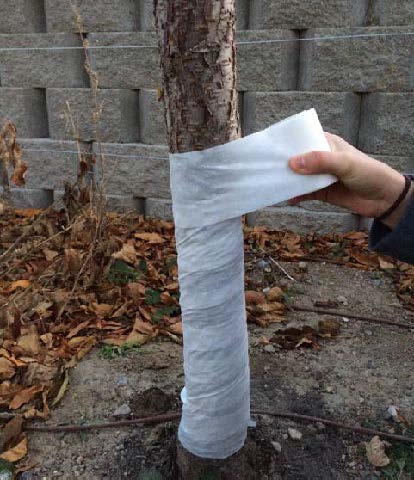
Wrapping young tree trunks with white reflective
wrap. (Image: Michael Caron)
Care for Young Trees and Shrubs
Many younger trees and even some older ones are susceptible to winter sun injury. This is often referred to as southwest winter injury or just sun scald. It is caused by repeated freezing and thawing of the bark exposed to winter sun. The bark is warmed considerably during the day, which causes sap flow. At night, as temperatures drop, the sap inside cells just under the bark freezes and causes the cells to rupture, and fissures and cracks appear in the bark. This damage is often not evident until the following growing season when the trees begin to grow.
To avoid this, young trees can be protected by wrapping them with reflective (white) tree wrap. This wrap, available at many local nurseries, garden centers and farm stores, helps reflect the winter sun from the trunk surface, allowing the trunk tissue to stay dormant. Wrap the trunk from the base of the tree to the lowest branches. Remove the wrap in the spring. Tree trunks can also be painted with white, water-based paint, as is often done on commercial fruit trees.
Pruning Trees and Shrubs
Pruning in the fall is not recommended, as plants are going dormant. Pruning often stimulates new growth or delays dormancy, which causes the plant to be more susceptible to damage from freezing temperatures. Wait until early spring, when the coldest part of winter has passed, to do any major pruning. Roses with long canes, or branches on other plants in danger of breaking under snow load, may be shortened as a preventive measure. Additionally, any dead, diseased or branches causing hazards in the yard should also be pruned whenever necessary.
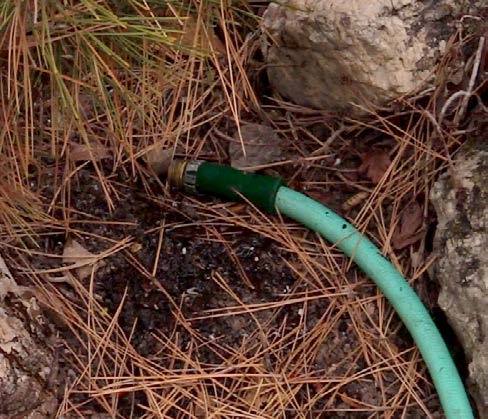
Deep water evergreens in the fall. (Image:
JayDee Gunnell)
Plant Trees, Shrubs and Spring Bulbs
Fall is the best time to plant nursery stock. Cooler weather makes the transition easier for the plants, and gives them a head start for next spring by producing root growth in the fall.
There are usually great deals at the nurseries and garden centers at this time of year. Nursery staff are also more able to spend time to help you select the right plants for the yard.
Ensure that landscape plants, such as trees and shrubs, have adequate soil moisture as they enter dormancy. Evergreens, never go truly dormant during the winter and may still need supplemental irrigation late in the season, especially if warm, dry weather persists. Newly planted trees, shrubs, and evergreens should be hand watered periodically during prolonged dry periods in the fall, or until the ground freezes.
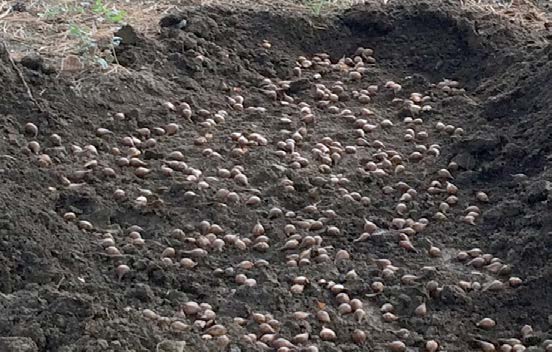
Spring flowering bulbs, such as tulips, daffodils and crocus, should be planted in the fall after the soils have cooled down from the summer heat but before the ground freezes. Plant bulbs 3 to 4 weeks before the ground freezes to ensure good root development.
As a general rule, plant bulbs 2 to 3 times as deep as the bulb is tall. Plant small bulbs, such as crocus, snowdrops and hyacinth, 3 to 4 inches deep. Larger bulbs such as daffodil, fritillary, and tulips should be planted between 6 and 8 inches deep (Cornwell, 2017). Fertilizer, especially phosphorus, and soil amendments are beneficial to bulb development and should be incorporated at planting and then as needed each spring as leaves emerge.
Lawn Care
Reduce mowing height to 1½ to 2 inches for the last mowing of the season (late October into November). This will reduce leaf length and help the occurrence of snow molds that are prevalent in areas with matted grass.
After the last mowing, apply a quick-release nitrogen fertilizer such as urea (46-0-0) or ammonium sulfate (21-0-0) at a rate of 1 pound of actual nitrogen per 1,000 ft2 . Keep in mind that the number on the fertilizer is a percentage of actual nitrogen. So, to get 1 pound of actual nitrogen, you would need to apply 2 pounds or urea (46-0-0) per 1,000 ft2 or 5 pounds of ammonium sulfate (21-0-0) per 1,000 ft2 . Even though the grass does not appear to be growing, the nitrogen will be stored in the root system, resulting in an early greening next spring.
Control Perennial Weeds
Perennial weeds such as dandelion, field bindweed, and Canada thistle, regrow every year from the same root system. They are best controlled with herbicides late in the season. In the fall, energy within the weeds moves into the root system to be stored until spring. Spraying herbicides at this time is most effective because they are more likely to reach the root system, resulting in better control (Beddes, 2015).
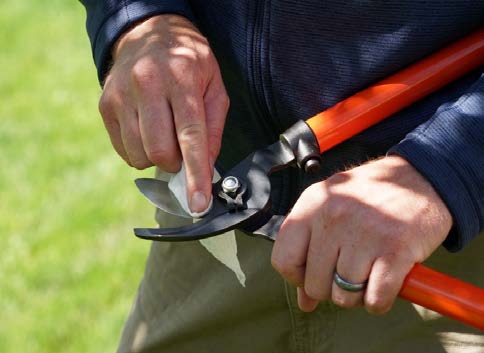
(Image: JayDee Gunnell)
Care for Machines and Tools
Fall is also a great time for maintenance of hand tools and garden equipment. Hand tools, such as shovels, hoes, loppers, and pruners, should be cleaned, sharpened and stored in a dry, protected area. Sharpen the beveled side of the blades with a hand file or ceramic sharpening stone.
Rubbing a small amount of lightweight oil, such as gun or pneumatic tool oil, onto the metal with a cloth will help prevent rusting. A little linseed oil also helps prevent wooden handles from cracking.
Unless the manufacturer states otherwise, it is usually best to drain gasoline from small engines when storing for the winter. As gasoline ages, varnishes and other deposits build up in the fuel system leading to difficult starting and expensive repairs. An alternative to draining the fuel system is to use a fuel stabilizer. These stabilizers, which are widely available, are added to gasoline to allow for long-term storage.
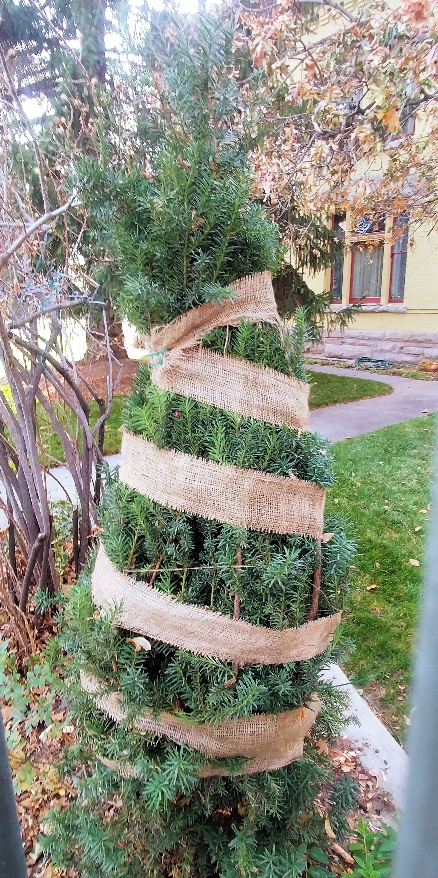
snow breakage. (Image: Taun Beddes)
Additionally, many mechanics recommend running ethanol free fuel through small engines the last few times the gas tank is filled as another method to prevent varnishing over the winter. General maintenance such as sharpening the mower blade, and changing the spark plug, engine oil, and air filters can also be done now to help ensure a trouble-free startup in the spring.
Other Timely Tips
Use burlap or other soft wrapping material to secure branches of columnar evergreens and similar plants that have the tendency to break or bend under snow loads. Burlap wrapped around arborvitae can also help protect against foraging deer during the winter months. When it does start to freeze and snow, use de-icing materials sparingly. These materials are salt derivatives and can damage plants.
Salt-laden snow sprayed on plants from adjacent roads and walkways can kill leaves directly. These products can also accumulate in soil and cause root damage or plant death in severe cases. The damage from these materials is usually not noticed until spring.
For a complete list of seasonal yard and garden chores, visit USU Extension’s Gardener’s Almanac at: https://extension.usu.edu/yardandgarden/monthlytips
References
- Beddes, T., Kopp, K., Whitesides, R., Gunnell, J., Caron, M. (2015). Weed control options for residential lawns in Utah. Utah State University Cooperative Extension. Logan, UT. Accessed February 22, 2018. Available at: http://digitalcommons.usu.edu/cgi/viewcontent. cgi?article=1774&context=extension_curall
- Farrell-Poe, K., Koenig, R. (2011). Backyard Composting in Utah. Utah State University Cooperative Extension. Logan, UT. Accessed February 22, 2018. Available at: https://digitalcommons.usu.edu/cgi/viewconten t.cgi?referer=&httpsredir=1&article=1489&con text=extension_curall
- Gunnell, J., Goodspeed, J., Hunter, B. (2015). Gardener’s Almanac monthly gardening tips. Utah State University Cooperative Extension. Logan, UT. Accessed February 22, 2018. Available at: https://extension.usu.edu/yardandgarden/month ly-tips
- Cornwell, R. (2017) Bulbs and more – planting and care. University of Illinois Extension. Urbana Champaign, Ill. Accessed October 24, 2017. Available at: http://extension.illinois.edu/bulbs/planting.cfm
- Heaton, K., Koenig, R. 2010. Solutions to soil Problems v. low organic matter. Utah State University Cooperative Extension. Logan, UT. Accessed February 22, 2018. Available at: http://digitalcommons.usu.edu/cgi/viewcontent. cgi?article=1957&context=extension_curall
Utah State University Extension
Peer-reviewed fact sheet
Download PDF
Authors
JayDee Gunnell, Extension Associate Professor; Michael Caron, Extension Assistant Professor; Taun Beddes, Extension Associate Professor; Linden Greenhalgh, Extension Associate Professor
Related Research






